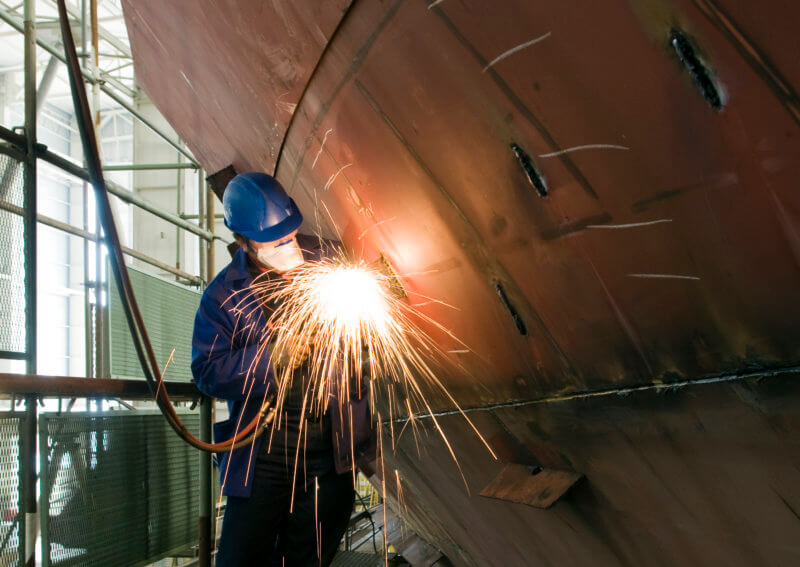Manufacturing companies are having a tough time filling jobs. Not only do they have to overcome the outdated impression of dirty or dangerous work, they have to contend with a skills gap and a predicted shortage of up to 2 million workers.
And even when a company does manage to fill positions, a recent study shows that nearly half of manufacturing companies report turnover of 20% or higher. So what’s a company to do?
Research finds that the shortage of workers often leads to overworked employees and low morale that can contribute to the “rotating door” effect. Below are are some clear actionable steps you can take to fight the skilled labor shortage and boost your retention rates.
1. Figure out why workers are quitting
Every company is different and there is no “one-size-fits-all” solution to avoid losing valuable manufacturing workers in this high turnover market. But there is one place every company should start: getting honest feedback from your employees.
In a recent Workstep survey, 83% of the workers we interviewed said they had worked at a company for “shorter” or “much shorter” time periods than they had intended when they took the job. In a nutshell: most people don’t take a job intending to quit after only a few months. So the key is uncovering the reasons why people are dropping off.
There are many ways to take action:
- Conduct a survey
- Collect anonymous feedback
- Make check-ins part of your management process
- Conduct a careful assessment of the way managers lead
- Have open conversations with managers and other workers who know what’s going on on the factory floor
These steps will allow you to identify the sources of your problems: is it pay? Employee burnout? Something else? Understanding why your workers are leaving is the first step to building a successful retention strategy that addresses these issues.
2. Set realistic expectations from the beginning
A good retention strategy starts by setting realistic expectations during the hiring process. In a competitive market, it’s tempting to gloss over more challenging aspects of a job. But setting realistic expectations builds a foundation of trust and stems drop off. In a recent workplace survey, employees cited a job that “wasn’t what they expected from the interview” as one of their top three reasons for quitting.
However, that doesn’t mean you have to be doom and gloom. Highlight opportunities for further training and career growth (see our next point). And develop a strong onboarding program to educate and train new workers since most drop off happens within the first six months (31% of new employees interviewed by BambooHR quit their job within the first 6 months).
Take action:
- Set realistic expectations in the hiring process
- Develop a strong onboarding program
- Assign mentors for new hires
3. Invest in ongoing employee training opportunities
A recent survey conducted by the Alliance for American Manufacturing found that 78% of respondents thought it was important to “offer more job training and education programs for workers.”
Training is especially vital in a manufacturing environment. For one thing, the technology involved in industrial jobs like CNC machining is constantly being updated. So ensuring that workers are up-to-date is vital for safety, productivity, and employee satisfaction. But, according to a recent report, less than half of manufacturing industry respondents thought that their company was training them to develop the right knowledge and skills.
And—there’s no way around it—training can be a big investment for a company, which can sometimes be a hard sell. “A lot of times the challenge is connecting worker investments to ROI,” said Tooling U-SME Vice President Jeannine Kunz. “And then connecting the fact that not developing people is truly causing your quality issues, your lack of productivity, your broken-down machines, and your rising tooling costs.”
Some ways to take action:
- Offer ongoing training to ensure your employees have the skills the need to succeed
- Pay attention to new technologies and make sure workers understand how to interact with them
- Invest heavily in training and onboarding during the first year of employment when turnover is the highest
4. Make a talent development strategy for every employee
Got a training program in place? Great. However, it may not be enough. Part of developing an effective retention strategy is helping your employees understand how to use available resources. In other words: you also need a talent development strategy. What does this look like?
First, manufacturing has to fight against the stereotype that it only offers rote tasks and “dead end” jobs. The best way to do this is by charting a clear career path for all your employees from day one. Find out where they want their jobs to take them and clearly lay out how they can get there through training and experience.
This kind of strategy will pay off in the long run, especially among the younger workforce. Millennials value opportunities for career advancement more than any other previous generation. In fact, 72% of millennials say they value opportunities for career advancement and the opportunity to learn new skills when they describe their ideal job (versus only 62% of gen Xers and 48% of boomers).
Some ways to take action:
- Make it clear advancement opportunities exist and how to access them
- Be clear on timelines for pay raises, promotions, and training opportunities so employees can set goals
By highlighting these opportunities, you might keep some of your most motivated—and often most valuable—employees, people who might otherwise leave for a better opportunity elsewhere.
5. Take a good look at your company culture
In a manufacturing environment, it’s vital to have facilities that are clean and safe. But successful employers will go beyond that to create a company culture that makes workers feel valued and respected.
Manufacturing workers in particular need to feel empowered to use their critical thinking skills to problem solve as part of the process. Managers who encourage this kind of input and feedback aren’t just building stronger teams, they’re building a strong company culture. And that’s good for business. In fact, a Columbia University study found that turnover at companies with rich culture was just 13.9% versus 48.4% at companies with poor culture.
Personal touches count too. Celebrate team milestones, host a quarterly barbeque. The little things count. Among workers in our survey who had no plans to leave their job, we often heard comments like “Everyone wants to be here and you feel welcomed” and “It’s rare to find a company that treats its employees like family.”
So how to create a culture that celebrates and values workers? Some ways to take action:
- Encourage an atmosphere of respect and respectful feedback
- Promote collaboration between production staff and management to improve problem solving
- Celebrate milestones like birthdays or promotions
- Host team meals and other team-building events
Take action today
In general, manufacturing companies are great at optimizing processes, but they need to pay equal attention to developing their workforce if they want them to stick around. Take action today to attract more skilled workers and boost your retention rates.
Tune into your frontline with WorkStep
With the frontline employee engagement platform that delivers the real-time insights you need to take action, retain your workforce, and drive your business forward.
Dan Johnston, Co-Founder & CEO | dan@workstep.com



